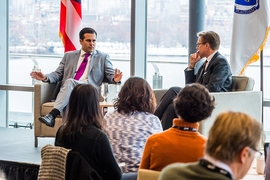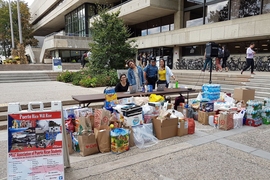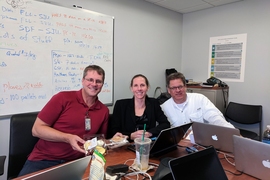Swanny Lamboy Rodriguez is not one to complain. The University of Puerto Rico (UPR) at Humacao senior, who will begin a doctoral program at MIT this fall, downplays the impact of Hurricane Maria, the historic storm that devastated her country last September.
“It was frustrating not to be able to communicate,” she admits.
Despite experiencing months without power, water, and other essentials, she feels lucky because her family’s home was left fairly intact. By contrast, her campus in Humacao, where she was studying biology, suffered extensive damage. All told, UPR’s 11 campuses sustained millions of dollars in damages from the storm.
Rodriguez resumed her studies at the end of October, but classes were held in tents. For her and many other students, prospects for continuing coursework and conducting research — and for seniors, completing degrees and applying for graduate programs — looked bleak if not impossible.
Then one day she drove to a WiFi hotspot and found an email waiting for her from Mandana Sassanfar, a MIT biology lecturer. It read: “If you get this message, we would like to offer you the opportunity to study here in the spring semester.”
Rodriguez took the offer, as did four other UPR seniors: Angel Astacio-Echevarria, Gabriel Colón-Reyes, Raul Mojica Soto-Albors, and Jean Carlos Vega-Díaz.
Vega-Díaz, an architecture major at the University of Puerto Rico at Rio Piedrasm, had been considering volunteering for clean-up service on the island when he received the good news.
“My entire family cried in disbelief when I received the invitation from MIT,” he says. “I thought, what university would care enough to provide this incredible life-changing opportunity?”
Strengthening ties
That opportunity came about thanks to Sassanfar, who also oversees diversity and outreach for the departments of Biology and Brain and Cognitive Sciences, and Gloria Anglón, assistant dean and director of diversity initiatives in the Office of Graduate Education (OGE), with help from faculty and administrators from across the Institute. Sassanfar and Anglón knew the students already, because all five of them had participated in the 2017 MIT Summer Research Program (MSRP).
Founded in 1986, each year MSRP serves about 40 undergraduate students from schools around the U.S. Aimed at underrepresented or underserved students, the program’s mission is to promote the value of graduate education, increase diversity, and prepare and recruit talented scholars for graduate school at MIT. There are currently two distinct programs: one specifically for biology and brain and cognitive sciences, and one for all other departments.
Inviting MSRP alumni from Puerto Rico to continue their studies at MIT made perfect sense, says Anglón. “They’ve already spent a summer here doing research, which we knew would help them acclimate more easily to the academic semester,” she says.
Anglón and Sassanfar chose seniors because their prospects for graduate school next year, at MIT or elsewhere, would suffer most if they did not graduate on time. To stay on track, the students took two or three classes and conducted research, which, for some, was a continuation their work during last summer’s MSRP.
After the students arrived in early February, a number of staff in OGE, the Office of the Vice Chancellor, and the Department of Biology provided additional support to ensure a smooth transition. They arranged a special orientation, connected the students with the Association of Puerto Rican Students at MIT, and held regular gatherings with staff and MSRP pod leaders — graduate students who guide and mentor students during the summer program.
Opening doors
Being on campus this spring was an eye-opener for the students. Rodriguez, whose research focused on lung cancer, was amazed at the size of one of her biology classes; she had never had a class with more than 25 people before. Even the modern facilities were a novelty. “I couldn’t believe that those chalkboards could move up and down in 10-250,” she says.
She and her fellow UPR students were also exposed to novel areas of study not available at their home institutions.
“We have no neuroscience research going on at my campus, so it’s a completely new thing to me,” says Raul Mojica Soto-Albors, a UPR at Mayaguez biology major. His work at the McGovern Institute for Brain Research involved characterizing neuron populations in the retrosplenial cortex of mice. Although he has additional coursework to complete at UPR next year, neuroscience has piqued his curiosity and he’s considering pursuing a PhD in the field. “I will totally apply to MIT,” he says.
Vega-Díaz found the architecture program at MIT quite distinct from UPR, where the focus is more on design within the context of spatial relations. MIT, he notes, integrates other parameters, like environmental tools to study the impact of solar power on energy consumption. He worked in the Urban Risk Lab, an interdisciplinary group of designers and researchers that develops ways to incorporate risk reduction and preparedness into urban and regional design.
“My life changed with this research group,” he says. “Since my time at MIT, I have become passionate about being a pioneer in Puerto Rico who can integrate communities into post-disaster reconstruction.” After he graduates this summer, he’ll return to the Urban Risk Lab as a research scientist for a year, while also working on a design portfolio for his graduate school application.
Finding equilibrium
Even during their short time, the visiting students faced a challenge common to many MIT students: balancing coursework, activities, and all of the opportunities to work independently and explore interdisciplinary studies.
“I was used to the work life I had going on at my institution,” says Soto-Albors. “But then coming here there’s so much more that you can do, there’s so many things available that you really have to set up your schedule and have serious time management skills.” On top of classes, he worked in the lab full time, often staying until 7 or 8 p.m. and then heading home to study and work on problem sets. “It was a nice experience particularly because of that,” he says, because it gave him a sense of what life is like as a graduate student.
Moreover, the students had to navigate an abrupt transition to a new culture and location. Rodriguez finished her coursework at UPR on Jan. 31, said a quick goodbye to her family, and hopped on a plane for Boston the next day.
“The most meaningful experience I had here was seeing myself slowly improve in classes after having dragged with me a lot of the indifference, academically speaking, the aftermath of the hurricane had left on me ... while being here, I saw myself improve and I knew that not all was lost.”
Sassanfar says MIT got as much out of the visit as the UPR students did.
“Seeing firsthand how hard the students worked and how much they benefited from this opportunity makes it all so worthwhile,” she says. “Not only does this directly impact diversity here, it also strengthens our existing relationships with faculty in Puerto Rico.”
Blanche Staton, a senior associate dean in OGE, echoes that sentiment.
“We were so pleased to have experienced the new perspective that these students brought to our campus, and are hopeful that they will be among our future graduate students,” she says. “They were clearly excited by their time here and will certainly act as ambassadors for the Institute.”









